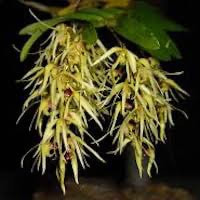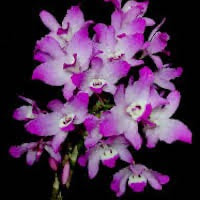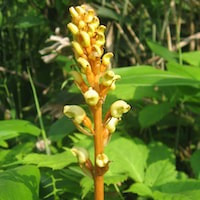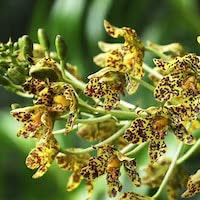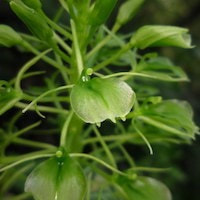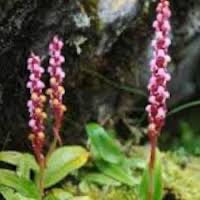WWD5 - Women's Woody 5 - Happy to tea you
|
Native Singaporean Orchid notes: Oncidium Twinkle
Oncidium Twinkle, a well-liked orchid, features in the perfume "Woody 5 (Women)" created in a team-building workshop. It's praised for being one of the top small Oncidiums due to its excellent qualities. This orchid is easy to grow, stays small, and blooms a lot, making it great for beginners and experts. It rarely gets sick, which makes people like it even more. Known for its woody smell with hints of spicy vanilla, Oncidium Twinkle adds depth and character to the fragrance, creating a delightful scent.
|
Therapeutic Orchid notes:
|
Dendrobium denudans D. Don
Dendrobium denudans, also called D. Don, is an orchid known for its purple-striped lip, blooming mainly from August to September. Besides being decorative, it holds traditional medicinal value. In the Darjeeling Himalayas, its raw pseudobulbs are eaten to ease fever and body pains. These bulbs are also used in making a narcotic remedy. It's important to note that these uses are based on tradition; seeking advice from a healthcare expert before medicinal use is wise due to potential variations in effectiveness and safety. |
|
Dendrobium linawianum Rchb. f.
Dendrobium linawianum, also known as Yinshihu, Jinshihu, Lishishihu, or Juchunshihu in Chinese, is a small to medium-sized orchid species found mainly in Wulai, Taiwan. It thrives in low-altitude broad-leaved forests. Apart from its beauty, this orchid is valued for its traditional medicinal properties. Its stem is used in herbal medicine to nourish yin and aid the stomach, helping with symptoms like thirst, heat sensation, dry mouth, weakness, poor health, night sweats, and joint pain. As with all herbal remedies, consulting a healthcare professional is advisable before use. |
|
Genus: Gastrodia R. Br.
Gastrodia, known as Tianma in Chinese and Oni No Yagara in Japanese, is a type of parasitic orchid lacking green leaves, relying on fungi for nutrients. Its tubers are irregularly shaped and found underground, resembling a stomach. In ancient Chinese tradition, Tianma, specifically Gastrodia elata, was taught by Shen Nong, the "Divine Farmer," for its medicinal benefits promoting health and longevity. It's listed by the World Health Organization as one of 150 medicinal plants in Korea. While Tianma holds cultural significance in herbal medicine, consulting a healthcare professional is advised for safe and effective use. |
|
Grammatophyllum scriptum (L.) Blume
Grammatophyllum scriptum, known as Leopard Orchid or Tiger Orchid, blooms primarily from April to May and is found from Borneo to the Pacific region. Traditionally, its pulp was mixed with turmeric for treating nailbed infections, while its pseudobulb sap was used to rinse the mouth for thrush and applied with ginger on the abdomen for intestinal issues and swollen spleens. These uses vary across cultures, so it's wise to seek advice from healthcare professionals or herbalists for safe and effective medicinal use. |
|
Liparis cordifolia Hook. f. Syn. Liparis argentopunctata Aver., Liparis keitaoensis Hayata
Liparis cordifolia, known as Silver Cricket Orchid or Xinyeyangersuan in Chinese, is studied for its chemical composition, particularly alkaloids like keitaonine and keitine. In Taiwanese herbal medicine, its root decoction is used to relieve abdominal pain due to its believed therapeutic properties. It's advised to use herbal remedies cautiously and consult with healthcare professionals before using them for medicinal purposes to ensure safety and effectiveness. |
|
Satyrium nepalense D. Don var. nepalense
Satyrium nepalense var. nepalense, known as Bird Feet Orchid or Dui dui shen in Chinese, is recognized for its medicinal uses rather than its fragrance. Indigenous communities utilize its tubers for treating malaria, dysentery, and as an aphrodisiac. The dried tubers are consumed as a tonic to prevent dysentery, and their juice is applied on wounds and used to manage fever. While historically associated with aphrodisiac qualities, specific details about its fragrance remain less documented in available research. |
Other scent note
Scentopia Library Reference ingredient
Angsana - Sentosa's plant - Check details at Scentopia's scent library
Download the guided mediation that works best with this Orchid fragrance oil
| women_woody_essential_oil_orchi_00005.mp3 | |
| File Size: | 163884 kb |
| File Type: | mp3 |

